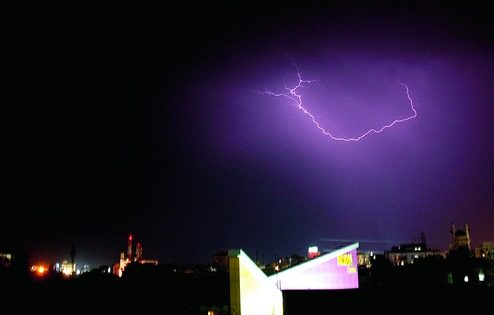The state emergency response centre, a centralised unit set up in Dhurwa to coordinate with districts and issue timely alerts, has stopped functioning from February, and the government displays no urgency to revive it even though
Jharkhand has already recorded more than 60 deaths due to lightning strikes since January.Today, according to police, three persons died after being struck by lightning while working in the fields at Garadih village at Kairo in Lohardaga. So far in June, 13 people have died of lightning strikes in the state, according to media reports and estimates provided by independent disaster management experts. In May, the toll was 40 across the state with 21 in East Singhbhum alone.According to sources, the state emergency response centre has ceased to function because state disaster management's special projects officer's post has been lying vacant ever since the contract of Col Sanjay Srivastava, an expert from UNDP, expired over three months back.
The special projects officer was to act as the nodal officer of the disaster management department, under the state home department, and coordinate with district disaster management officers (DDMOs), local administrations and stakeholders during exigencies.

Streaks of lightning across Ranchi sky
The officer was to monitoring the state emergency response centre, prepare plans to counter threats and initiate research activities from time to time.
But now, at the district level, too, more than 90 per cent of DDMOs have stopped functioning because either their contracts weren't renewed and or they weren't paid salaries for as much as nine months, the sources revealed.
"Disaster management exists only on paper at the moment in Jharkhand," said an expert, who till recently was associated with the state. He said the emergency response centre stopped functioning because of the lackadaisical attitude of the state government.
"For the state emergency centre, we lobbied with National Disaster Management Authority to get Rs 1.20 crore a couple of years back. Equipment like v-sat, dedicated internet communications and satellite phones, were being installed, besides host of high-end computers. But, there is no one to run the centre. We couldn't use half the funds as the state government didn't provide proper space or resources," he said, adding that four engineers and experts brought in by him to work at the centre had also left.
In the last fiscal that ended in March, Jharkhand could not even utilise funds allocated for disaster management work.
"Rs 15 lakh for mock drills was surrendered. NDMA gave Rs 1.28 crore for disaster related preparedness in 2016-17 and 2017-18. Half the funds for the last fiscal were surrendered. I don't know if the remaining amount could be utilised this year or not," he added.
On lightning deaths, another disaster management official maintained that there were no casualties in places where safe lightning grids had been installed over the last couple of years.
"After the 2012 lightning strike on the Baidyanath temple at Deoghar, we created a safe grid there. In the last two years, not a single lightning death has occurred in that area. Similar grids were created at Nandan Pahar in Deoghar, which are working fine and there has been no report of any casualty or injuries," he said adding that in Rajaulatu in Namkum, they had moved a plan over a year back to set up a safe grid, but that has not seen the light of day.
It was ironical, he said, that the state government was okay with giving out compensation to the families of those dying of lightning strikes, but wasn't willing to initiate steps to reduce them.
"There is no data on how many buildings in the state have lightning arrestors/conductors. We don't know if they work or not.... All this is because of the lack of dedicated disaster management professionals," he added.
Home secretary S.K.G Rahate said they had requested the state urban development department to amend building bylaws and make lightning arrestors/conductors mandatory on new constructions.
"Like water harvesting, we also requested the urban development department to make lightning arrestors mandatory on every building. This can be one of the options to minimise lightning incidents. About gathering intelligence regarding lightning, we usually rely on the weather department," he told The Telegraph.
On the moribund emergency response centre and the lack of DDMOs in the state, Rahate said they were working on it. "We had asked UNDP to continue till contracts were renewed but many left midway. We hope to sort out the issue of DDMOs at the cabinet level," Rahate said.
Reader Comments
to our Newsletter